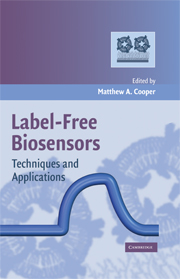Book contents
- Frontmatter
- Contents
- Contributors
- Preface
- LABEL-FREE BIOSENSORS
- 1 Label-free optical biosensors: An introduction
- 2 Experimental design
- 3 Extracting affinity constants from biosensor binding responses
- 4 Extracting kinetic rate constants from binding responses
- 5 Sensor surfaces and receptor deposition
- 6 Macromolecular interactions
- 7 Interactions with membranes and membrane receptors
- 8 Application of SPR technology to pharmaceutical relevant drug-receptor interactions
- 9 High-throughput analysis of biomolecular interactions and cellular responses with resonant waveguide grating biosensors
- 10 ITC-derived binding constants: Using microgram quantities of protein
- 11 Electrical impedance technology applied to cell-based assays
- Index
- Plate section
6 - Macromolecular interactions
Published online by Cambridge University Press: 05 May 2010
- Frontmatter
- Contents
- Contributors
- Preface
- LABEL-FREE BIOSENSORS
- 1 Label-free optical biosensors: An introduction
- 2 Experimental design
- 3 Extracting affinity constants from biosensor binding responses
- 4 Extracting kinetic rate constants from binding responses
- 5 Sensor surfaces and receptor deposition
- 6 Macromolecular interactions
- 7 Interactions with membranes and membrane receptors
- 8 Application of SPR technology to pharmaceutical relevant drug-receptor interactions
- 9 High-throughput analysis of biomolecular interactions and cellular responses with resonant waveguide grating biosensors
- 10 ITC-derived binding constants: Using microgram quantities of protein
- 11 Electrical impedance technology applied to cell-based assays
- Index
- Plate section
Summary
THE SCOPE OF MACROMOLECULAR INTERACTIONS
Interactions between proteins constitute the best-characterized and perhaps largest family of interactions between biological macromolecules. This is partly because of the long-recognized diversity of the protein constituents of cells. The significance of diversity in nucleic acids, lipids, and carbohydrates is becoming more apparent, but proteins have held pride of place as the carriers of biological specificity for many decades. It is also partly because the diversity of protein structure and function is so easily observed in contrast to the more subtle variations that determine the specificity of other macromolecules. It is not surprising, therefore, that the bulk of biomolecular interaction studies performed with optical biosensors involves protein–protein binding. The technology can in principle be used to monitor any molecular interactions, and studies involving nucleic acids answer for a significant fraction of the published literature.
Proteins lend themselves well to biomolecular interaction work with optical biosensors. The wealth of functional groups on a “standard” protein molecule offers a selection of approaches for attaching interactants to the sensor surface, ranging from amine- or thiol-based chemical coupling to specific high-affinity capturing methods. Membrane-associated proteins can be embedded in lipid layers on the sensor surface to preserve a hydrophobic environment. Commonly, proteins are relatively large molecules with molecular weights from tens up to hundreds of kilodaltons, so the response obtained in mass-concentration detection methods like surface plasmon resonance (SPR) is usually well above the detection limit of the instrumentation. In addition, most protein–protein interactions can be broken by exposure to moderately mild conditions, offering good opportunities for efficient surface regeneration.
Information
- Type
- Chapter
- Information
- Label-Free BiosensorsTechniques and Applications, pp. 143 - 158Publisher: Cambridge University PressPrint publication year: 2009
Accessibility standard: Unknown
Why this information is here
This section outlines the accessibility features of this content - including support for screen readers, full keyboard navigation and high-contrast display options. This may not be relevant for you.Accessibility Information
- 1
- Cited by
